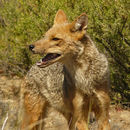en
names in breadcrumbs


The South American foxes (Lycalopex), commonly called raposa in Portuguese, or zorro in Spanish, are a genus from South America of the subfamily Caninae. Despite their name, they are not true foxes, but are a unique canid genus more closely related to wolves and jackals than to true foxes; some of them resemble foxes due to convergent evolution. The South American gray fox, Lycalopex griseus, is the most common species, and is known for its large ears and a highly marketable, russet-fringed pelt.
The second-oldest known fossils belonging to the genus were discovered in Chile, and date from 2.0 to 2.5 million years ago, in the mid- to late Pliocene.[4] The Vorohué Formation of Argentina has provided older fossils, dating to the Uquian to Ensenadan (Late Pliocene).[5]
The common English word "zorro" is a loan word from Spanish, with the word originally meaning "fox". Current usage lists Pseudalopex (literally: "false fox") as synonymous with Lycalopex ("wolf fox"), with the latter taking precedence.[1][6] In 1895, Allen classified Pseudalopex as a subgenus of Canis, establishing the combination Canis (Pseudalopex), a name still used in the fossil record.[2]
Species currently included in this genus include:[1]
In 1914, Oldfield Thomas established the genus Dusicyon, in which he included these zorros. They were later reclassified to Lycalopex (via Pseudalopex) by Langguth in 1975.[1]
The following phylogenetic tree shows the evolutionary relationships between the Lycalopex species, based on molecular analysis of mitochondrial DNA control region sequences.[7]
LycalopexLycalopex sechurae (Sechuran fox or Peruvian desert fox)
Lycalopex fulvipes (Darwin's fox)
Lycalopex gymnocercus (pampas fox) ![]()
Lycalopex griseus (South American gray fox or chilla)
Lycalopex culpaeus (culpeo or Andean fox) ![]()
The zorros are hunted in Argentina for their durable, soft pelts. They are also often labelled 'lamb-killers'.
The Fuegian dog (Spanish: perro yagán, perro fueguino), also known as the Yaghan dog, was a domesticated form of the culpeo (Lycalopex culpaeus),[8] unlike other domesticated canids which were dogs and silver foxes. This means different canid species have been domesticated multiple times by humans independently.
{{cite web}}: CS1 maint: postscript (link) The South American foxes (Lycalopex), commonly called raposa in Portuguese, or zorro in Spanish, are a genus from South America of the subfamily Caninae. Despite their name, they are not true foxes, but are a unique canid genus more closely related to wolves and jackals than to true foxes; some of them resemble foxes due to convergent evolution. The South American gray fox, Lycalopex griseus, is the most common species, and is known for its large ears and a highly marketable, russet-fringed pelt.
The second-oldest known fossils belonging to the genus were discovered in Chile, and date from 2.0 to 2.5 million years ago, in the mid- to late Pliocene. The Vorohué Formation of Argentina has provided older fossils, dating to the Uquian to Ensenadan (Late Pliocene).